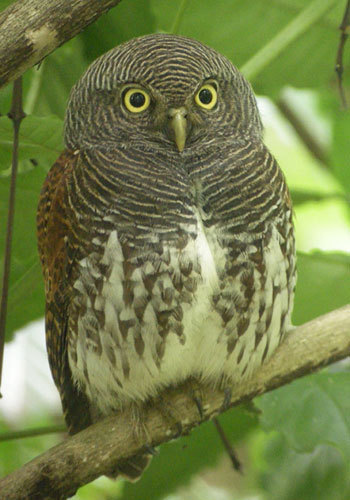Chestnut-backed Owlet (Glaucidium castanonotum)
If you happend to hear a deep and slow kraw-kraw sound in the evenings just look at the tall trees around you to a swarm of small birds. It is known as the chestnut-backed Owlet.
Known among Sri Lankans as Pitathambala Wana Bassa is an owl endemic to Sri Lanka. This species is part of the larger grouping of owls known as typical owls, Strigidae, which contains most species of owl.
The Chestnut-backed Owlet is small (19 cm) and stocky. It resembles the Jungle Owlet in shape, size and appearance but the upperparts, scapulars and wing coverts are mainly chestnut brown, with darker barring. The underparts, are white with blackish shaft-streaks. The facial disc is mainly brown and the eyes are yellow. There is a white neckband.
The Chestnut-backed Owlet is a reident bird in the wet zone rainforests of Sri Lanka and can be seen at Kitulgala and Sinharaja rainforest.
This species is diurnal and is frequently seen in the day, especially in the evening. The flight is deeply undulating. It frequents tops of tall trees, usually on steep hill-sides and hence is often missed. It feeds mainly on insects, such as beetles, but also captures mice, small lizards, and small birds mostly when the young are being fed.

Known among Sri Lankans as Pitathambala Wana Bassa is an owl endemic to Sri Lanka. This species is part of the larger grouping of owls known as typical owls, Strigidae, which contains most species of owl.
The Chestnut-backed Owlet is small (19 cm) and stocky. It resembles the Jungle Owlet in shape, size and appearance but the upperparts, scapulars and wing coverts are mainly chestnut brown, with darker barring. The underparts, are white with blackish shaft-streaks. The facial disc is mainly brown and the eyes are yellow. There is a white neckband.
The Chestnut-backed Owlet is a reident bird in the wet zone rainforests of Sri Lanka and can be seen at Kitulgala and Sinharaja rainforest.
This species is diurnal and is frequently seen in the day, especially in the evening. The flight is deeply undulating. It frequents tops of tall trees, usually on steep hill-sides and hence is often missed. It feeds mainly on insects, such as beetles, but also captures mice, small lizards, and small birds mostly when the young are being fed.


